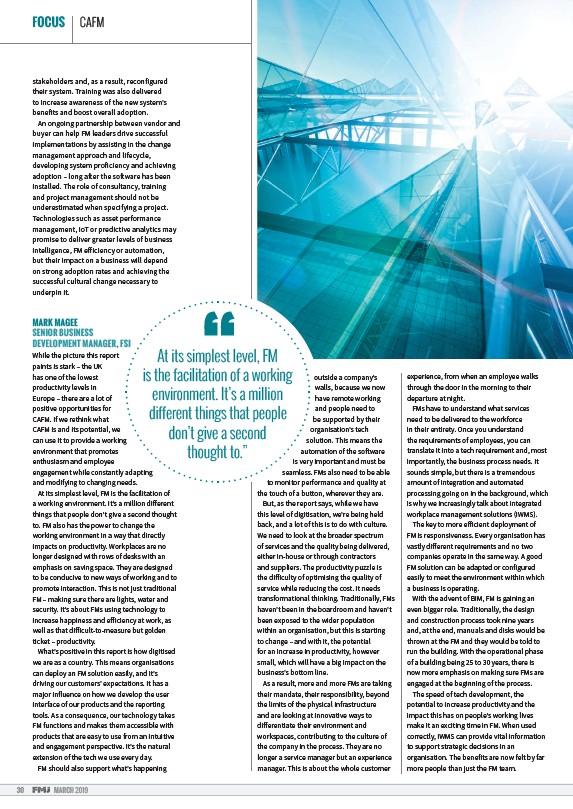
FOCUS CAFM
stakeholders and, as a result, reconfigured
their system. Training was also delivered
to increase awareness of the new system’s
benefits and boost overall adoption.
An ongoing partnership between vendor and
buyer can help FM leaders drive successful
implementations by assisting in the change
management approach and lifecycle,
developing system proficiency and achieving
adoption – long a„ er the so„ ware has been
installed. The role of consultancy, training
and project management should not be
underestimated when specifying a project.
Technologies such as asset performance
management, IoT or predictive analytics may
promise to deliver greater levels of business
intelligence, FM e iciency or automation,
but their impact on a business will depend
on strong adoption rates and achieving the
successful cultural change necessary to
underpin it.
MARK MAGEE
SENIOR BUSINESS
DEVELOPMENT MANAGER, FSI
While the picture this report
paints is stark – the UK
has one of the lowest
productivity levels in
Europe – there are a lot of
positive opportunities for
CAFM. If we rethink what
CAFM is and its potential, we
can use it to provide a working
environment that promotes
enthusiasm and employee
engagement while constantly adapting
and modifying to changing needs.
At its simplest level, FM is the facilitation of
a working environment. It’s a million di erent
things that people don’t give a second thought
to. FM also has the power to change the
working environment in a way that directly
impacts on productivity. Workplaces are no
longer designed with rows of desks with an
emphasis on saving space. They are designed
to be conducive to new ways of working and to
promote interaction. This is not just traditional
FM – making sure there are lights, water and
security. It’s about FMs using technology to
increase happiness and e iciency at work, as
well as that di icult-to-measure but golden
ticket – productivity.
What’s positive in this report is how digitised
we are as a country. This means organisations
can deploy an FM solution easily, and it’s
driving our customers’ expectations. It has a
major influence on how we develop the user
interface of our products and the reporting
tools. As a consequence, our technology takes
FM functions and makes them accessible with
products that are easy to use from an intuitive
and engagement perspective. It’s the natural
extension of the tech we use every day.
FM should also support what’s happening
30 MARCH 2019
outside a company’s
walls, because we now
have remote working
and people need to
be supported by their
organisation’s tech
solution. This means the
automation of the so„ ware
is very important and must be
seamless. FMs also need to be able
to monitor performance and quality at
the touch of a button, wherever they are.
But, as the report says, while we have
this level of digitisation, we’re being held
back, and a lot of this is to do with culture.
We need to look at the broader spectrum
of services and the quality being delivered,
either in-house or through contractors
and suppliers. The productivity puzzle is
the di iculty of optimising the quality of
service while reducing the cost. It needs
transformational thinking. Traditionally, FMs
haven’t been in the boardroom and haven’t
been exposed to the wider population
within an organisation, but this is starting
to change – and with it, the potential
for an increase in productivity, however
small, which will have a big impact on the
business’s bottom line.
As a result, more and more FMs are taking
their mandate, their responsibility, beyond
the limits of the physical infrastructure
and are looking at innovative ways to
di erentiate their environment and
workspaces, contributing to the culture of
the company in the process. They are no
longer a service manager but an experience
manager. This is about the whole customer
experience, from when an employee walks
through the door in the morning to their
departure at night.
FMs have to understand what services
need to be delivered to the workforce
in their entirety. Once you understand
the requirements of employees, you can
translate it into a tech requirement and, most
importantly, the business process needs. It
sounds simple, but there is a tremendous
amount of integration and automated
processing going on in the background, which
is why we increasingly talk about integrated
workplace management solutions (IWMS).
The key to more e icient deployment of
FM is responsiveness. Every organisation has
vastly di erent requirements and no two
companies operate in the same way. A good
FM solution can be adapted or configured
easily to meet the environment within which
a business is operating.
With the advent of BIM, FM is gaining an
even bigger role. Traditionally, the design
and construction process took nine years
and, at the end, manuals and disks would be
thrown at the FM and they would be told to
run the building. With the operational phase
of a building being 25 to 30 years, there is
now more emphasis on making sure FMs are
engaged at the beginning of the process.
The speed of tech development, the
potential to increase productivity and the
impact this has on people’s working lives
make it an exciting time in FM. When used
correctly, IWMS can provide vital information
to support strategic decisions in an
organisation. The benefits are now felt by far
more people than just the FM team.
At its simplest level, FM
is the facilitation of a working
environment. It’s a million
diff erent things that SeoSle
don’t give a second
thought to.”